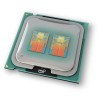- Qualcomm Launches Snapdragon 4 Gen 2 Mobile Platform
- AMD Launches Ryzen PRO 7000 Series Mobile & Desktop Platform
- Intel Launches Sleek Single-Slot Arc Pro A60 Workstation Graphics Card
- NVIDIA Announces Latest Ada Lovelace Additions: GeForce RTX 4060 Ti & RTX 4060
- Maxon Redshift With AMD Radeon GPU Rendering Support Now Available
Intel Core 2 Quad Q9450 2.66GHz

The wait for an affordable 45nm Quad-Core is now over, and the Q9450 promises to become the ultimate choice of the new offerings. It’s not much slower than the QX9650, offers 12MB of cache and as expected, has some fantastic overclocking ability. How does 3.44GHz stable sound?
Page 12 – Power Consumption, Temperatures
Before we delve into these two tests, we have to admit that these results are in no way definitive. We conduct these with rather simple means and variances beyond what our equipment can see might occur. That said, we still consider these results to be reliable, but for various reasons, they wouldn’t be 100% spot-on.
To test for power consumption, we use the trusty Kill-A-Watt monitor. For a reminder of our machine specs, please refer to our testing methodology page. Our Kill-A-Watt is plugged directly into the wall, and our PC directly into it. Nothing else shares the socket in order to keep fluctuations to a minimum.
For our idle results, we boot up the machine and leave it at the desktop for five minutes and grab the result that’s on the Kill-A-Watt. If for some reason the wattage is fluctuating, we’ll wait until it stabilizes. Vista can sometimes run random processes which can make it difficult to get a reliable result. For our load result, we run Cinebench R10 and grab the highest average wattage during the peak of the benchmark.

The Q9450 is faster than the Q6600, but uses less power. That’s what we like to see.
To gather our temperatures, we use Everest 4.0 and record for five minutes after boot, while the computer sits idle. Afterwards, we load up enough instances of SP2004 to keep the CPU at 100% usage and again record using Everest for 15 minutes. After that, we grab both the idle and load average temperature. Please note that we grab the temperature for the entire CPU, not an individual core.
As I’ve mentioned in the past, there is no reliable way to capture the real temperature of the processor, although “Real Temp” might be the best application for finding the most accurate one. The absolute best way to capture the real temperature would be to use a High-K temperature diode, but that’s impossible (unless of course you don’t want to use a CPU cooler).

Again, similar to our power consumption tests, the faster Q9450 runs cooler than the last-gen Q6600, at both idle and load.
Support our efforts! With ad revenue at an all-time low for written websites, we're relying more than ever on reader support to help us continue putting so much effort into this type of content. You can support us by becoming a Patron, or by using our Amazon shopping affiliate links listed through our articles. Thanks for your support!





